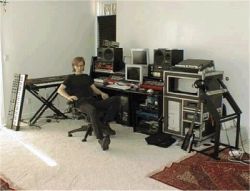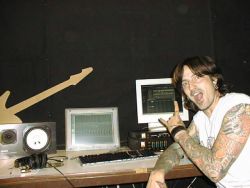Steve Duda
|
How did you get involved in creating music ?
I was “forced” to play violin as a kid, I was terrible at sight-reading (the co-ordination to play the instrument was enough work for me) so I started playing by ear, and learning the songs only by hearing them. This worked well until I started taking piano lessons, there is a lot more notes to hear in your head on piano 🙂 How did you end up using FL Studio ?
In 1998 I was having fun hacking Rebirth, putting new samples in the software with a resource editor. They got smart in the 1.5 Rebirth, allowing for you to create “mods” with ease. However, around this same time I discovered Fruityloops. It allowed for drag-and-drop WAV with unlimited stepsequencer channels! This was my first attraction to FL, a simple stepsequencer/sample player where you could browse and replace samples with ease.
It was clear that the creator of the program had an eye for design and attention to detail. Fruityloops back then was a basic software drum machine, but the very best one that time. I’m very glad it has grown with the times.
What does FL Studio mean in your current setup ?
FL means a whole lot, if I were restricted to one item of music software on my PC, it would certainly be FL.
I use FL for software testing – it is quick to launch and debugger-friendly at this point (I’ve gotten into software development the last few years, with Devine-Machine, Fxpansion BFD, and recently Devine-Machine Lucifer VST, my first hand-coded effect plugin).
FL is not only the fastest program to start up, it’s also the fastest environment to take a musical idea from your head to your speakers. There is so much ability, and so little limitation in FL that the main limitation is the users musical imagination.
I have a particular fondess for the FL FormulaController/Peak Controller, VSTi/VST FX hosting, ASIO multiple outputs, and the beloved FruitySlicer!
What are the advantages/ disadvantages of using hardware & software ?
This is a subject which is problematic because it compares two things which are so fundamentally different.
Analog hardware has qualities that can and will (theoretically) be reproduced digitally, however there is not enough performance (and DSP sophistication) to reproduce all of the subtlties – such as distortion non-linearities – of hardware in current computers..
Theres something to be said for tradition and nostalgia – Many “classic” records of the 1980’s and 1990’s were made with hardware samplers, hardware synths, etc. These were the only tools available, and people would spend a lot of money on studio time just to have access to the gear. Due to the limitations of the gear, people would make the best of what they had, which brings me to another important point.
Hardware tends to have a bit more care and thought put in to parameter ranges and such. Its tough to generalize because a lot of students can make a VSTi synthesizer, where a hardware one takes money and most often some professional design.
The limitations found in hardware force people to use their ears and choose from a limited number of choices. Sometimes audio software provides too many choices. This is because the computer programmers are too close to the theory, they don’t see any reason to make their compressor/delay/EQ/etc have restrictions. If a Linn LM-1 drum machine had 1000 kickdrum and snare samples to choose from instead of one, would those Prince songs sound as good? Instead of spending an hour trying 100 kick drums, you have to do what you can with the one you have (perhaps adjust tone and decay) and get back to making a song instead of “tweaking out”. |
What albums have you worked on so far ?
I’ve worked on a lot of records in many different ways. My most common gigs have been programming and editing, but I get a lot of mixing and keyboard gigs as well. Here’s a partial disography:
Tommy Lee in front of FL Studio
|

